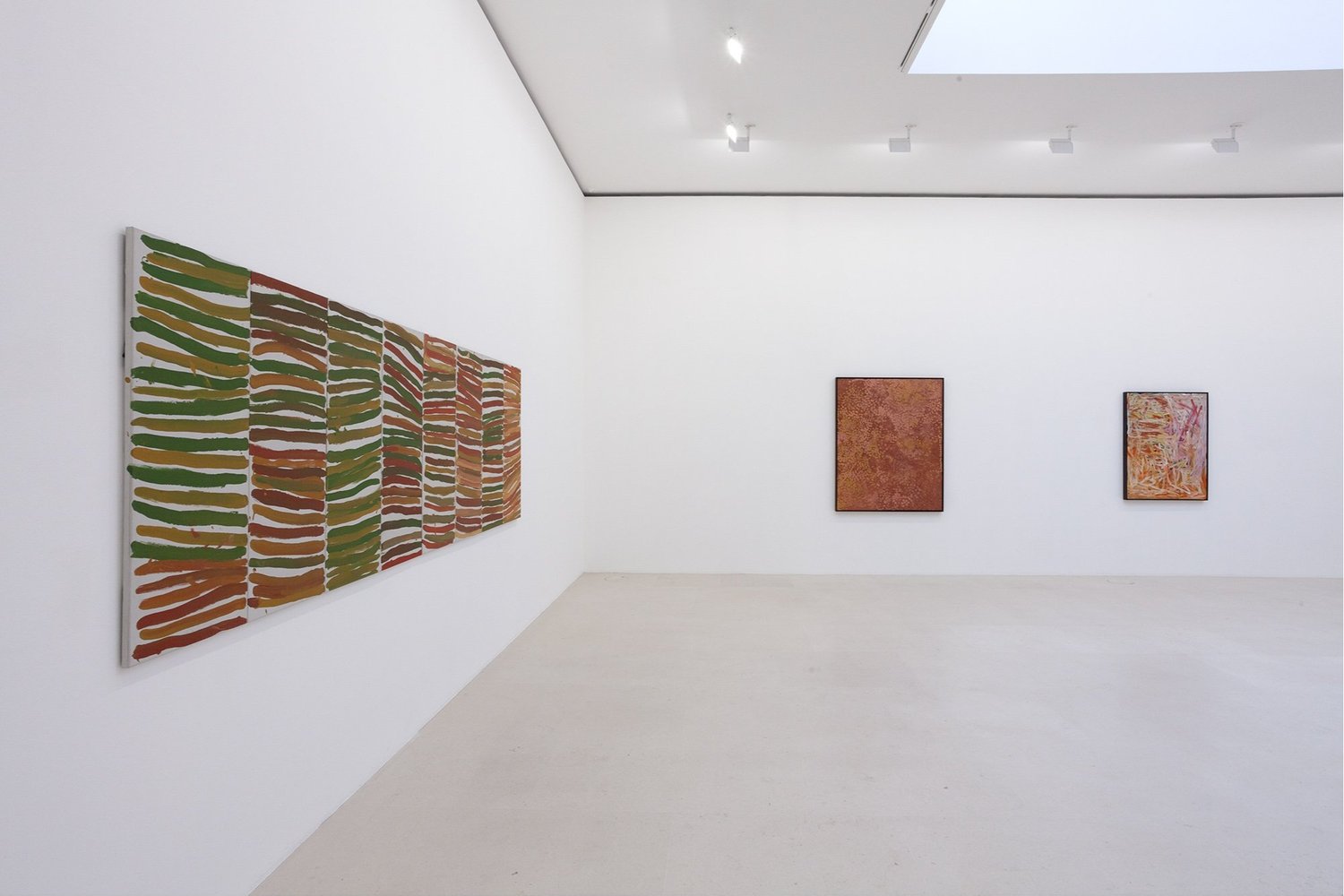Emily Conquers Paris With A Solo Show
A small but powerful exhibition in France of work by the late Emily Kame Kngwarreye is a harbinger of resurgent interest in Aboriginal art, writes Dan F. Stapleton.

Emily: Desert Painter of Australia. Gagosian Paris. Installation view. Photograph by Zarko Vijatovic
A selection of just 14 paintings by one of Australia’s most highly acclaimed Indigenous artists has opened at a world- leading contemporary gallery in Paris. Small it may be, but Emily: Desert Painter of Australia, feels like a big moment for the late Emily Kame Kngwarreye.
The sheer diversity of the work showing at Gagosian’s Rue de Ponthieu gallery creates the impression that Kngwarreye (1910–1996) spent a lifetime exploring different styles on canvas. In fact, the revolutionary Australian Aboriginal artist painted all 14 high-energy pictures during the final seven years of her life – along with more than 3000 others.
The last major attempt to summarise her relentless pursuit of new forms and colours was the 2008 retrospective Utopia: The Genius of Emily Kngwarreye at the National Museum of Australia. That show comprised 120 paintings. By comparison, Kngwarreye’s first solo exhibition in France is petite. But it hits just as hard. What’s more, many of the works are top tier.
In collaboration with Melbourne gallery D’Lan Contemporary, Gagosian has sourced examples of Kngwarreye’s best- known styles, including Awelye, a luminous painting from 1990 in which scatterings of dots cover a curvy web, and 1994’s Untitled – Alhalkere, a monumental line-based composition from the ‘‘Body Paint’’ series.
Also represented are styles that were largely absent from the Utopia retrospective but have lately become sought-after, including Winter Awelye I, an astonishing piece from 1994 in which metre-long trails of large dots create the impression of rippling tendrils.
It’s a powerful assemblage of paintings and an indication that Gagosian is taking Kngwarreye very seriously indeed.
Over the past three years, Larry Gagosian’s mega-gallery has mounted two other exhibitions of Australian Indigenous art with D’Lan Contemporary, in Los Angeles and Hong Kong.
But those were group shows. Being granted a solo exhibition puts Kngwarreye in the company of Cy Twombly, Helen Frankenthaler and Jeff Koons and brings her into the global contemporary art conversation like never before.
“I don’t think we could achieve greater visibility with any other gallery in the world,’’ says D’Lan Contemporary founder D’Lan Davidson. He credits Louise Neri, the Melbourne-raised Gagosian director, with putting Australian Indigenous art firmly on the agenda at her Manhattan HQ.
Davidson’s gallery has lately mounted its own shows of Australian Indigenous art and Gagosian are working co-operatively, not in competition. ‘‘Louise and I have worked together for three years now, and we respect each other and what we each bring to the table,’’ he says.
Speaking for his gallery, he adds: ‘‘We want the relationship with Gagosian to continue to grow and flourish, for the benefit of First Nations artists. And we see it doing so.’’
Kngwarreye is already trending overseas, with works currently on view at Tate Modern in London and big sales at the recent Sotheby’s Aboriginal Art auctions in New York.
Davidson believes all that’s holding her back from greater success internationally is the variable quality of some of the many works attributed to her.
Rumours of Kngwarreye forgeries have long circulated in the Australian media. In 1997, the NT News even reported on an organised ‘‘school’’ of painters creating ‘‘fake Emilys’’. ‘‘That’s why our two galleries are presently working on a comprehensive document that will provide assurance on provenance for the international market,’’ Davidson says.
So, which of Kngwarreye’s works are considered bullet-proof?
Davidson says the only two lines of provenance that his gallery and Australia’s major museums currently accept are Delmore Gallery, which operated on a homestead adjacent to Kngwarreye’s homeland of Utopia (north-east of Alice Springs), and Rodney Gooch, an Alice Springs-based arts worker who facilitated Kngwarreye’s first works on canvas.
‘‘Presently – aside from a handful of additional works that were verified for the retrospective – we’re not prepared to go any further than that,’’ he says.
The Gagosian show contains paintings from both lines of provenance. Together, they show how Kngwarreye moved between aesthetics with ease.
The eight-panel Untitled – Alhalkere work (Gooch) and the vastly different Winter Awelye picture (Delmore) were both painted in mid-1994.
Christopher Hodges, whose Utopia Art Sydney gallery handled the sale of Gooch works throughout Kngwarreye’s career in the 1990s, says the artist’s stylistic transformations never ceased to shock the Australian scene.
The ‘Body Paint’ series almost broke the market,’’ he says. But that particular shift, he explains, was born of necessity. ‘‘She was seriously ill at the time and she realised that her heart condition was not going away. Nonetheless, she demanded to keep working.’’
The lines were inspired by the body painting that Kngwarreye had practised all her life while living on Country. ‘‘She was going back to the basics of her belief system,’’ notes Hodges.
Over at Delmore Downs, Kngwarreye was producing various smaller works in bright palettes, often changing styles from day to day. Winter Awelye I, a larger piece at
1.5×1.2 metres, is a remarkable physical achievement for an 80-something artist whose health was failing. ‘‘That period of work is a bit of a mishmash,’’ says Davidson. ‘‘But when the paintings hit the mark, they are truly melodic and spectacular.’’
Of the two 1994 works, only Winter Awelye I is for sale (Untitled – Alhalkere is a loan). Neri won’t specify exactly how many other pieces remain available. ‘‘But Gagosian tells me there have been several significant sales already,’’ says Davidson.
‘‘I firmly believe that the market for Emily’s work is now in the beginning stages of a whole new trajectory,’’ he adds.
The Australian Financial Review, 4-6 February 2022.